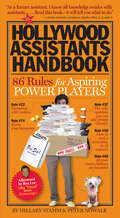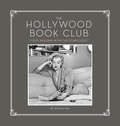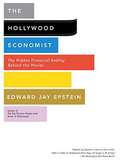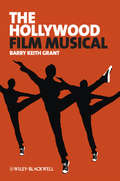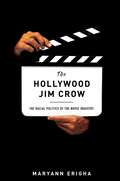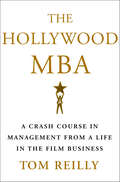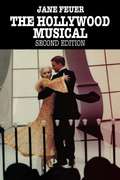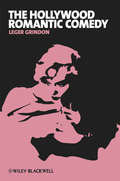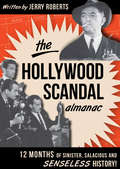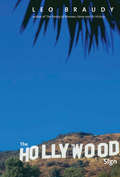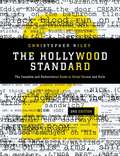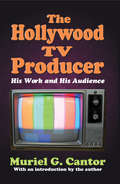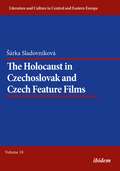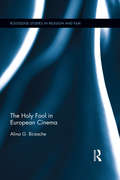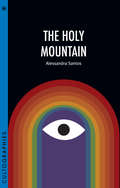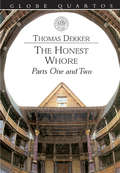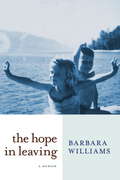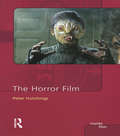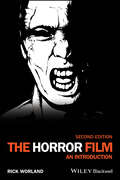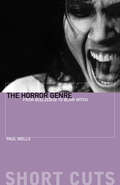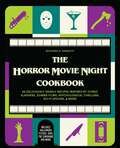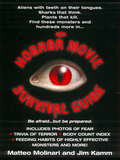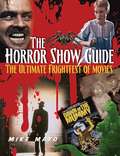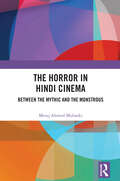- Table View
- List View
The Hollywood Assistants Handbook: 86 Rules for Aspiring Power Players
by Peter Nowalk Hillary StammAre you young, eager, smart, and heading off to LA to make it big in the entertainment business? Time for a reality check: Leave your diploma at home, put your grandiose dreams on hold (where hopefully they'll get tired and hang up), and start by repeating the first rule of the industry: Who you work for is more important than who you are. Then leapfrog over everyone else by reading The Hollywood Assistants Handbook. Written by two very sharp and successful assistants to HPPs (Hollywood Power Players), here are 86 lessons packed with a combination of blunt truth, insider humor, and juicy secrets that explain the unwritten rules of how to get a foot in the door and make all the right moves as you climb to the top. Here are the minimum-wage jobs that will put you in the path of HPPs. An annotated resume roundup. The clubs to frequent and the cocktails to order. Movies to watch and books to read (it's called homework). Dressing do's and don'ts. How to get on the Free List. A lineup of boss genres—the Horror Show, the Romantic Comedy, Mr. Action—and how to dodge the tirades that will soon be hurled your way, along with the proper outlets for venting. Plus, the ins and outs of your most important tool, the telephone—when to listen in (always!), who to put through and who to put off, and your new best friend forever, the Plantronics CS70 cordless headset. With its hilariously snarky tone—the gate-keeping quiz is "How to Tell if You're a Moron Who Should Pack Up the Corolla and Move Back Home"—The Hollywood Assistants Handbook is as baldly entertaining for everyone who loves reading about Hollywood as it is indispensably practical for the job-seeker.
The Hollywood Book Club
by Steven ReaAudrey Hepburn, Humphrey Bogart, Gregory Peck, Rita Hayworth, Marilyn Monroe—the brightest stars of the silver screen couldn't resist curling up with a good book. This unique collection of rare photographs celebrates the joy of reading in classic film style. The Hollywood Book Club captures screen luminaries on set, in films, in playful promotional photos, or in their own homes and libraries with books from literary classics to thrillers, from biographies to children's books, reading with their kids, and more. Featuring nearly 60 enchanting images, lively captions about the stars and what they're reading by Hollywood photo archivist Steven Rea, here's a real page-turner for booklovers and cinephiles.
The Hollywood Economist: The Hidden Financial Reality behind the Movies
by Edward Jay EpsteinIn a Freakonomics meets Hollywood saga, veteran investigative reporter Edward Jay Epstein goes undercover to explore Hollywood's "invisible money machine," probing the dazzlingly complicated finances behind the hits and the flops, while he answers the surprisingly puzzling question: How do the studios make their money? Along the way we also learn much about star system and what makes the business tick: + What it costs to insure Nicole Kidman's right knee ... + How and why the studios harvest silver from old film prints ... + Why stars do--or don't do--their own stunts ... + Why Arnold Schwarzenegger is considered a contract genius ... + How Hollywood goes about doping outside investors and hedge fund managers ... + Why Lara Croft: Tomb Raider is considered a "masterpiece" of financing.
The Hollywood Film Musical (New Approaches to Film Genre #24)
by Barry Keith GrantThis revealing history of the American film musical synthesizes the critical literature on the genre and provides a series of close analytical readings of iconic musical films, focusing on their cultural relationship to other aspects of American popular music. Offers a depth of scholarship that will appeal to students and scholars Leads a crucial analysis of the cultural context of musicals, particularly the influence of popular music on the genre Delves into critical issues behind these films such as race, gender, ideology, and authorship Features close readings of canonical and neglected film musicals from the 1930s to the present including: Top Hat, Singin' in the Rain, Woodstock, Gimme Shelter, West Side Story, and Across the Universe
The Hollywood Jim Crow: The Racial Politics of the Movie Industry
by Maryann ErighaThe story of racial hierarchy in the American film industry The #OscarsSoWhite campaign, and the content of the leaked Sony emails which revealed, among many other things, that a powerful Hollywood insider didn’t believe that Denzel Washington could “open” a western genre film, provide glaring evidence that the opportunities for people of color in Hollywood are limited. In The Hollywood Jim Crow, Maryann Erigha tells the story of inequality, looking at the practices and biases that limit the production and circulation of movies directed by racial minorities. She examines over 1,300 contemporary films, specifically focusing on directors, to show the key elements at work in maintaining “the Hollywood Jim Crow.” Unlike the Jim Crow era where ideas about innate racial inferiority and superiority were the grounds for segregation, Hollywood’s version tries to use economic and cultural explanations to justify the underrepresentation and stigmatization of Black filmmakers. Erigha exposes the key elements at work in maintaining Hollywood’s racial hierarchy, namely the relationship between genre and race, the ghettoization of Black directors to black films, and how Blackness is perceived by the Hollywood producers and studios who decide what gets made and who gets to make it. Erigha questions the notion that increased representation of African Americans behind the camera is the sole answer to the racial inequality gap. Instead, she suggests focusing on the obstacles to integration for African American film directors. Hollywood movies have an expansive reach and exert tremendous power in the national and global production, distribution, and exhibition of popular culture. The Hollywood Jim Crow fully dissects the racial inequality embedded in this industry, looking at alternative ways for African Americans to find success in Hollywood and suggesting how they can band together to forge their own career paths.
The Hollywood MBA: A Crash Course in Management from a Life in the Film Business
by Tom ReillyWhat would you do if alligators were loose in your office? Or if your place of business changed 80 times during a four month period? What if two of your key employees were infant twins? Or you were asked to manage 130 people who were hired yesterday?Tom Reilly has faced these obstacles and thousands more in his three-decade career managing major motion pictures. He’s led more than 100,000 employees and been responsible for overseeing over two billion dollars in pro-rated production budgets and learned that successful management isn’t about what you want; the question is, what do you NEED?Often filming at live locations, Reilly was forced to adopt a unique set of strategies to accommodate for extreme workplace conditions and the challenge of leading and managing big budget projects, a revolving-door workforce of technicians, and actors such as Al Pacino, Robert de Niro, Tom Hanks, Charlize Theron, Sean Connery, and Harrison Ford.In The Hollywood MBA, Reilly explores the ten key strategies he utilized to manage big crews, big budgets, and big personalities on major motion pictures, and shows us how these strategies can be leveraged in any business for success.With an eye for making small adjustments to management strategy that produce big results, Reilly utilizes the narrative backdrop of the film set as an extreme case study in modern management identifying proven, easy-to-implement, and often counter intuitive practices that will increase engagement, team cohesion, efficiency, creativity, quality, and the bottom line in any industry.
The Hollywood Musical
by Jane FeuerThis study traces the origins of the musical along with providing a comprehensive analysis of their affects on society
The Hollywood Romantic Comedy: Conventions, History, Controversies (New Approaches To Film Genre Ser.)
by Leger GrindonThe most up-to-date study of the Hollywood romantic comedy film, from the development of sound to the twenty-first century, this book examines the history and conventions of the genre and surveys the controversies arising from the critical responses to these films. Provides a detailed interpretation of important romantic comedy films from as early as 1932 to movies made in the twenty-first century Presents a full analysis of the range of romantic comedy conventions, including dramatic conflicts, characters, plots, settings, and the function of humor Develops a survey of romantic comedy movies and builds a canon of key films from Hollywood's classical era right up to the present day Chapters work as discrete studies as well as within the larger context of the book
The Hollywood Scandal Almanac: 12 Months of Sinister, Salacious and Senseless History!
by Jerry RobertsA &“this day in Hollywood history&” reference that recounts the scandals of the stars—from Charlie Chaplin to Charlie Sheen. The real-life scandals of Hollywood&’s personalities rival any drama they bring to life on the silver screen. This book provides 365 daily doses of high and low crimes, fraud and deceit, culled from Tinseltown&’s checkered past. Whether it&’s the exploits of silent-era star Fatty Arbuckle, the midcentury misdeeds of Frank Sinatra and Marilyn Monroe, or the modern excesses of Lindsay Lohan, this calendar of Hollywood transgressions has a sensational true tale for every day of the year. It&’s an entertaining and sometimes shocking trip down memory lane filled with sneaky affairs, box-office bombs, and careers cut short—sometimes by murder. It shows that the drama doesn&’t end when the credits roll.
The Hollywood Sign: Fantasy And Reality Of An American Icon (Icons of America)
by Leo BraudyThe story behind the massive white block letters set into a steep Los Angeles hillside—and the city and culture they represent: &“Terrific.&”—San Francisco Chronicle To so many who see its image, the Hollywood sign represents the earthly home of that otherwise ethereal world of fame, stardom, celebrity—the American and worldwide aspiration to be in the limelight, to be, like the Hollywood sign itself, instantly recognizable. How an advertisement erected in 1923, touting the real estate development Hollywoodland, took on a life of its own is a story worthy of a movie itself. Leo Braudy traces the remarkable life of this distinctly American landmark, which has been saved over the years by a various fans and supporters, among them Alice Cooper and Hugh Hefner, who spearheaded its reconstruction in the 1970s. He also uses the sign&’s history to offer an intriguing look at the rise of the film business from its earliest, silent days through the development of the studio system that helped define modern Hollywood. Mixing social history, urban studies, literature, and film, along with forays into such topics as the lure of Hollywood for utopian communities and the development of domestic architecture in Los Angeles, The Hollywood Sign is a fascinating account of how a temporary structure has become a permanent icon of American culture. &“An entertaining tale.&”—The Washington Post
The Hollywood Standard: The Complete and Authoritative Guide to Script Format and Style (2nd edition)
by Christopher Riley"The Hollywood Standard" describes, in clear, vivid prose and hundreds of examples, how to format every element of a screenplay or television script. A reference for everyone who writes for the screen, from the novice to the veteran, this is the dictionary of script format, with instructions for formatting everything from the simplest master scene heading to the most complex and challenging musical underwater dream sequence. This new edition includes a quick start guide, plus new chapters on avoiding a dozen deadly formatting mistakes, clarifying the difference between a spec script and production script, and mastering the vital art of proofreading. For the first time, readers will find instructions for formatting instant messages, text messages, email exchanges and caller ID.
The Hollywood Studios: House Style In The Golden Age Of The Movies
by Ethan MorddenHollywood in the years between 1929 and 1948 was a town of moviemaking empires. The great studios were estates of talent: sprawling, dense, diverse. It was the Golden Age of the Movies, and each studio made its distinctive contribution. But how did the studios, "growing up" in the same time and place, develop so differently? What combinations of talents and temperaments gave them their signature styles? These are the questions Ethan Mordden answers, with breezy erudition and irrepressible enthusiasm, in this fascinating and wonderfully readable book. Mordden illuminates how the style of each studio was primarily dictated by the personality, philosophy, and attitudes of its presiding mogul-and how all these factors affected the work and careers of individual actors, directors, writers, and technicians, and the success of the studio in general.
The Hollywood TV Producer: His Work and His Audience
by Muriel G. CantorExcept for accounts of journalists, dissident employees, and an occasional congressional committee focusing on crime and unethical practices, we have known very little about how television programs are produced. The Hollywood TV Producer, originally published in 1971, was the first serious examination of constraints, conflicts, and rewards in the daily lives of television producers. Its insights were important at the time and have not been challenged.Using as her framework the social system of mass communications, Muriel G. Cantor shows how producers select stories for television series and how movies end up in prime time. In order to get a comprehensive look at the inner workings of the TV industry and its producers, the author interviewed eighty producers in Hollywood over a two-season period. She probed to discover how the people producers work for and where they work influences their decision-making.As Cantor shows, critics of television who suggest that to remain in production, a producer must first please the business organization that finances his or her operations, are largely correct. Cantor shows that content is determined by a combination of artistic and professional factors, as well as social, economic, and political norms that have developed over time in the industry.
The Holocaust in Czechoslovak and Czech Feature Films (Literatur Und Kultur Im Mittleren Und Östlichen Europa Ser. #19)
by Šárka SladovníkováŠárka Sladovníková analyzes the depiction of the Holocaust in Czechoslovak and Czech feature films and the relevant literary pretexts. While she charts the social and cultural framework in which the films were made and how this framework changed, she also focuses on the cinematic language, the composition of and narration in each film (e.g., the depiction of the war and the Shoah as a narratively closed versus a narratively open event), genre aspects of the films (e.g., the use of comedy and humor), and convention and innovation in presenting motifs and characters (the division of gender roles, the character of the “good German”). Particular attention is paid to the portrayal of stereotypes and countertypes in the films, where already well-known images, situations, and backdrops are repeated and which meet viewers’ expectations or, in contrast, which form countertypes and countersituations that go against the grain. Many of the films analyzed are adaptations of literary works. Therefore, this book is also a contribution to the rapidly developing field of adaptation studies.
The Holy Fool in European Cinema (Routledge Studies in Religion and Film)
by Alina G. BirzacheThis monograph explores the way that the profile and the critical functions of the holy fool have developed in European cinema, allowing this traditional figure to capture the imagination of new generations in an age of religious pluralism and secularization. Alina Birzache traces the cultural origins of the figure of the holy fool across a variety of European traditions. In so doing, she examines the critical functions of the holy fool as well as how filmmakers have used the figure to respond to and critique aspects of the modern world. Using a comparative approach, this study for the first time offers a comprehensive explanation of the enduring appeal of this protean and fascinating cinematic character. Birzache examines the trope of holy foolishness in Soviet and post-Soviet cinema, French cinema, and Danish cinema, corresponding broadly to and permitting analysis of the three main orientations in European Christianity: Orthodox, Catholic, and Protestant. This study will be of keen interest to scholars of religion and film, European cinema, and comparative religion.
The Holy Mountain (Cultographies)
by Alessandra SantosAlejandro Jodorowsky's El Topo helped inaugurate the midnight movie phenomenon. Its success spawned The Holy Mountain, through interventions by John Lennon and Allen Klein. After a scandalous release and a 16-month midnight career, The Holy Mountain was relegated to the underground world of fan bootlegs for over thirty years until its limited restored release in 2007. This short study reveals how The Holy Mountain, a poetic, hilarious, and anarchist cult film by an international auteur, anchored in post-1968 critiques, is – at the same time – an archaeological capsule of the counterculture movement, a timely subversion of mystical tenets, and one of the most mysterious films in the history of world cinema.
The Honest Whore: With The Humours Of The Patient Man, And The Loving Wife (classic Reprint) (Globe Quartos)
by Thomas DekkerFirst Published in 1999. Routledge is an imprint of Taylor & Francis, an informa company.
The Hope in Leaving: A Memoir
by Barbara WilliamsHandsome Jack is a logger, nomad, and born dreamer. His young wife, Simone, has too many kids and never enough money to support or protect them. The family keeps on the move, shedding a grand total of twenty-seven homes. Their first child, Randy, is sensitive and brilliant and bold, protector of his younger siblings, the fearless star of their childhood adventures and misadventures--until something snaps inside him. The second child who comes a year after him, our narrator Barbara, is the lucky one, who can dream of getting out. Every time the family relocates, she feels "the hope in leaving and doing better next time."Poverty, mental illness, sexual abuse, and injustice pursue them wherever they go. They live small-town life hard and suffer, most of all Randy. The great surprise of The Hope in Leaving isn't that these characters descend increasingly into isolation and strife, but that despite this they remain a family, that there is always the spark of wit in their banter, and a kind of closeness no matter what happens, even a sense of normalcy. Gradually, the reader comes to understand why The Hope in Leaving is a book that had to be written. In it, Williams proves beyond doubt that there is one thing that can survive the worst of life and even death itself: love without judgment.From the Hardcover edition.
The Horror Film
by Peter HutchingsThe Horror Film is an in-depth exploration of one of the most consistently popular, but also most disreputable, of all the mainstream film genres. Since the early 1930s there has never been a time when horror films were not being produced in substantial numbers somewhere in the world and never a time when they were not being criticised, censored or banned. The Horror Film engages with the key issues raised by this most contentious of genres. It considers the reasons for horror's disreputability and seeks to explain why despite this horror has been so successful. Where precisely does the appeal of horror lie? An extended introductory chapter identifies what it is about horror that makes the genre so difficult to define. The chapter then maps out the historical development of the horror genre, paying particular attention to the international breadth and variety of horror production, with reference to films made in the United States, Britain, Italy, Spain and elsewhere. Subsequent chapters explore: The role of monsters, focusing on the vampire and the serial killer. The usefulness (and limitations) of psychological approaches to horror. The horror audience: what kind of people like horror (and what do other people think of them)? Gender, race and class in horror: how do horror films such as Bride of Frankenstein, The Texas Chainsaw Massacre and Blade relate to the social and political realities within which they are produced? Sound and horror: in what ways has sound contributed to the development of horror? Performance in horror: how have performers conveyed fear and terror throughout horror's history? 1970s horror: was this the golden age of horror production? Slashers and post-slashers: from Halloween to Scream and beyond. The Horror Film throws new light on some well-known horror films but also introduces the reader to examples of noteworthy but more obscure horror work. A final section provides a guide to further reading and an extensive bibliography. Accessibly written, The Horror Film is a lively and informative account of the genre that will appeal to students of cinema, film teachers and researchers, and horror lovers everywhere.
The Horror Film: An Introduction (New Approaches to Film Genre #3)
by Rick WorlandA lively and reliable narrative account of the horror genre, featuring new and revised material throughout The Horror Film: An Introduction surveys the history, development, and social impact of the genre. Covering American horror cinema from its earliest period to the present, this reader-friendly volume explores the many ways horror movies have been received by filmmakers, critics, and general audiences throughout the decades. Concise, easily accessible chapters describe historical instances of the genre's social reception based on primary research, analyze landmark films such as Frankenstein, Invasion of the Body Snatchers, and The Texas Chain Saw Massacre, and more. Incorporating recent scholarship on the genre, the second edition of The Horror Film contains new discussion and context for Hollywood horror films in the 1980s and 1990s, as well as notable developments in the genre such as “torture porn,” found-footage horror, remakes and reboots of past horror films, zombies, and the “elevated horror” debate. This edition explores the rise of new filmmakers such as Ari Aster, Robert Eggers, and Jordan Peele, surveys horror films made by women and African American filmmakers, and investigates contemporary issues in the production and consumption of horror films. Combining historical narrative with close readings of significant works, The Horror Film: Covers major works in the genre such as Cat People, Halloween, and Bram Stoker's Dracula Examines important antecedents including gothic literature and the Grand Guignol Theater Offers thorough analyses of the style, context, and themes of specific horror milestones Provides examples of close analysis that can be applied to a wide range of other horror films Discusses important representative titles across the genre's evolution, including more recent films such as 2017's Get Out The Horror Film: An Introduction, Second Edition, is an ideal textbook for undergraduate surveys of the horror genre and other courses in American film history, and an invaluable resource for scholars, lecturers, and general readers with an interest in the subject.
The Horror Genre: From Beelzebub to Blair Witch (Short Cuts)
by Paul WellsA comprehensive introduction to the history and key themes of the genre. The main issues and debates raised by horror, and the approaches and theories that have been applied to horror texts are all featured. In addressing the evolution of the horror film in social and historical context, Paul Wells explores how it has reflected and commented upon particular historical periods, and asks how it may respond to the new millennium by citing recent innovations in the genre's development, such as the "urban myth" narrative underpinning Candyman and The Blair Witch Project. Over 300 films are treated, all of which are featured in the filmography.
The Horror Movie Night Cookbook: 60 Deliciously Deadly Recipes Inspired by Iconic Slashers, Zombie Films, Psychological Thrillers, Sci-Fi Spooks, and More (Includes Halloween, Psycho, Jaws, The Conjuring, and More) (Gifts For Movie And Tv Lovers Ser.)
by Richard S. SargentSlay movie night with frighteningly delicious food and cocktail creations inspired by your favorite scary movies, perfect for fans of spooky season and movie buffs alike!If you're looking for kitschy Pinterest recipes like coffin-shaped cookies or zombie finger sandwiches, look elsewhere. With The Horror Movie Night Cookbook, you&’ll enjoy thoughtful and tasty food and cocktail pairings inspired by the actual content of chilling classics like Jaws, Psycho, Scream, The Conjuring, The Evil Dead, Halloween, and more of horror&’s most frightening favorites! Inside you&’ll find recipes like: Crawling Steak (Poltergeist) Campfire Sour (The Blair Witch Project) Zombie Baby Kale Salad (Dawn of the Dead) Bloody Floaties (Jaws) Alligator Bites (Crawl) The Mama&’s Boy Martini (Psycho) And more! This killer cookbook contains everything you'll need to be the star of your own horror-themed dinner party. So to quote a famous final girl, &“What are you waiting for?&”
The Horror Movie Survival Guide
by Jim Kamm Matteo MolinariFrom the scream of Psycho to the psycho of Scream, The Horror Movie Survival Guide is an essential source for information on the creatures and monsters that darken your daydreams and stalk your nightmares. Includes a directory of the scariest films, 30 photos of the creepiest monsters, and a body count index of the deadliest killers.
The Horror Show Guide
by Mike MayoFrom atomic bombs to zealous zombies, this cinefile's guidebook reviews 1,000 of the wickedest, weirdest, and wackiest scary movies from every age of horror. With reviews on many overlooked, underappreciated gems such as Alice Sweet Alice, Daughters of Darkness, and Zombie, as well as the numerous Stephen King adaptations and modern updates such as Night of the Living Dead 3D and The Wolfman, new devotees as well as the discriminating darkcinema enthusiast will love this big, beautiful, endall, beall guide to an always popular film genre. Established directors, including Wes Craven, John Carpenter, Tim Burton, David Cronenberg, and Guillermo del Toro are given their due, as are the new generation, represented by Larry Fessenden, James Wan, Alexandre Aja, and others. In addition to the hundreds of horror film reviews, this guide includes fascinating and fun top10 lists and sidebars that are designed to lead fans to similar titles they might not have known about.
The Horror in Hindi Cinema: Between the Mythic and the Monstrous
by Meraj Ahmed MubarkiThe book offers a lively and detailed analysis of the ideological subtext of Hindi Horror cinema. It unearths its codes and conventions, its relationship to spectatorship, the genre’s conjunctions and departures from Hollywood, and the unique features of Hindi horror. It posits the Hindi horror genre as a project of / for the ‘nation’ in the making.Analysing films from Mahal (1948) to Bhediya (2022), this book uncovers narrative strategies, frames unique approaches of investigation, and reviews the transformation taking place within the genre. It argues that Hindi horror cinema lies at the intersection of myths, competing ideologies, dominant socio-religious thoughts revealing three major strands of narrative constructs, each corresponding to the way the nation has been imagined at different times in post-colonial India. It establishes a theoretical framework of Hindi horror cinema, and demonstrates for the first time how this genre, with its subsets, provides a means to contemplate the nation.This volume will be useful to students, researchers and faculty members working in mass communication, journalism, political science, film studies, political sociology, gender / women studies, Culture studies and post-colonial Indian politics. It will also be an invaluable and interesting reading for those interested in South Asian popular culture studies.
